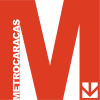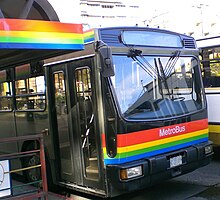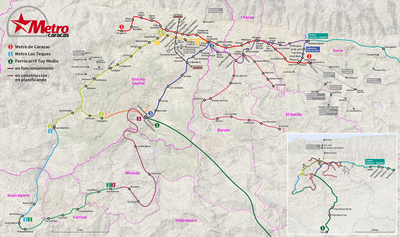| This article needs to be updated. Please help update this article to reflect recent events or newly available information. (November 2019) |
You can help expand this article with text translated from the corresponding article in Spanish. (May 2014) Click for important translation instructions.
|
| Caracas Metro | |
|---|---|
 | |
 Los Jardines station in 2010 Los Jardines station in 2010 | |
| Overview | |
| Native name | Metro de Caracas |
| Locale | Caracas, Venezuela |
| Transit type | Rapid transit |
| Number of lines | 4 (+ Los Teques Metro) |
| Number of stations | 46 (51 incl. Los Teques Metro) |
| Daily ridership | 2,500,000 (July 2018) |
| Operation | |
| Began operation | January 2, 1983 |
| Operator(s) | C.A. Metro de Caracas |
| Technical | |
| System length | 54.1 km (33.6 mi) 63.6 km (39.5 mi) (incl. Los Teques Metro) |
| Track gauge | 1,435 mm (4 ft 8+1⁄2 in) standard gauge |
| Electrification | 750 V DC third rail |



The Caracas Metro (Spanish: Metro de Caracas) is a mass rapid transit system serving Caracas, Venezuela. It was constructed and is operated by Compañía Anónima Metro de Caracas, a government-owned company that was founded in 1977 by José González-Lander who headed the project for more than thirty years since the early planning stages in the 1960s. Its motto is "Somos parte de tu vida" (translated as 'We are part of your life'). In 1978 MTA – New York City Transit's R46 #816 (now 5866) was shipped from the Pullman Standard's plant as a sample of rolling stock to be used for the new metro system that was under construction at the time.
It was inaugurated on January 2, 1983 with 11.5 km (7.1 mi) and currently the total length of the railway reaches 106.5 km (66.2 mi). Its purpose is to contribute to the development of collective transportation in Caracas and its immediate area, through the planning, construction, and commercial exploitation of an integrated transportation system. The C. A. Metro de Caracas is in charge of its construction, operation and exploitation as a decentralized public body attached to the Ministry of People's Power for Land Transportation.
As a consequence of the crisis that the country is experiencing, by October 2018 it was estimated that 25% of the Caracas Metro trains were out of service due to lack of maintenance. In 2020, 9 of them remain operational. 48 trains on Line 1; 6 of 44 on Line 2; and 4 of 16 on Line 3; which, together with electrical failures, causes users to experience permanent delays. In 2022, the Caracas Metro only had 23 of the 169 trains operational.
The system has 53 stations. The company is run by Major General Juan Carlos Du Bolay Perozo.
Lines
Main article: List of Caracas Metro stationsThe Caracas Metro currently has the following lines in operation:
| Line | Section | Length | Stations | Transfer Stations |
Notes |
|---|---|---|---|---|---|
| 1 | Propatria ↔ Palo Verde |
20.4 km | 22 | 4 | The original 8 station line began operations on Jan. 2, 1983 and expanded 3 more times; the latest and final rail expansion of this line occurred on Nov. 19, 1989. The Capitolio station was redesigned to allow passenger transfer by way of a passageway to and from the El Silencio station. Also the Plaza Venezuela station was twice remodelled, first to accommodate line 3 transfer (1994) and later a passageway to the Zona Rental station (2006). |
| 2 | El Silencio ↔ Zoológico |
17.8 km | 13 | 3 | A short run service was opened Oct 4, 1987 and fully expanded to El Silencio on Nov 6, 1988. The original line use has changed; before Line 4 opened on July 18, 2006, the train from the terminal station El Silencio served both Las Adjuntas and Zoológico terminal stations. |
| 3 | Plaza Venezuela ↔ La Rinconada |
10.4 km | 9 | 2 | The original line opened in Dec. 18, 1994 and operated between Plaza Venezuela and El Valle. In 2006 an extension to La Rinconada began to operate partially (Users had to transfer trains at El Valle stations). In 2010 three new stations were inaugurated and the line became fully operational between Plaza Venezuela and La Rinconada. |
| 4 | Zona Rental ↔ Capuchinos ( ↔ Las Adjuntas) |
5.5 km | 5 | 3 | Shortly after Line 4 was opened, it was co-named line 2, at this time Caracas Metro makes no distinction between the 2 separate lines other than that they serve distinct terminal stations. |
| TOTAL: | 54.1 km | 46 | |||
| Los Teques Metro | Las Adjuntas ↔ Independencia |
11.2 km | 5 | 1 | Opened in 2006. Also operated by Metro de Caracas. Effectively operates as an extension of Line 2/4. |
These lines were built between 1978 and 2006. Line 2 has four terminal stations.
Part of Line 2 was constructed as Line 4, but after its inauguration it was renamed Line 2. One must transfer on Line 3 at El Valle station to continue the ride.
Construction of the first phase of Line 4 (now officially renamed Line 2) started in 2001; this line runs parallel to Line 1 to the south, and connects Plaza Venezuela station on Line 1 with Capuchinos station on Line 2. It is expected to provide much needed relief to congestion along this segment of Line 1 where most of Metro's ridership is concentrated.
Commuter rail transfer points



Construction was begun on the Los Teques Metro from Caracas Metro Las Adjuntas station (the expanded station with independent platforms connected by overhead walkways is now common to both metro systems) to the suburban city of Los Teques Alí Primera (formerly called El Tambor) station in 2001 and completed November 3, 2006.
IFE
| This section does not cite any sources. Please help improve this section by adding citations to reliable sources. Unsourced material may be challenged and removed. (February 2024) (Learn how and when to remove this message) |
Line 3 station La Rinconada is the interchange station between the Caracas Metro and the Caracas train station Libertador Simón Bolívar, where connections can be made to and from Charallave and Cúa.
Guarenas/Guatire Metro
The Guarenas / Guatire Metro is a new line with the intention of providing access to the eastern suburban communities. Both subsystems would allow for transfers at the Guaraira Repano (Petare North) station. In December 2006, the government awarded a 2 billion dollar contract for the construction of the new line between a soon-to-be-built Caracas Metro Parque del Este II station and the nearby twin cities of Guarenas/Guatire, with completion set for July 2012. However, by November 2012, only 7% of the metro project had been completed, and the completion date had slipped to at least 2016. As of November 2022, there is no official opening date.
Services
| This section does not cite any sources. Please help improve this section by adding citations to reliable sources. Unsourced material may be challenged and removed. (February 2024) (Learn how and when to remove this message) |
Metrobus
The system possesses a complementary bus transit network called the Metrobus, which covers 20 urban routes and four suburban routes, with the aim of transporting users to other popular destinations in the Greater Caracas area that are not reached by the metro, including bedroom communities close to the city.
External ticket sale
A modality implanted by the enterprise is the wholesale of tickets used in the Metro and in the Metrobús. A number of tickets is sold to some middlemen, and from there to authorized points of sale, such as kiosks and other commercial establishments. This allows Metro users to buy tickets outside of the stations, thus making them more widely available. The points of sale formally authorized for these operations are identified with the Metroseñal (Metro-sign). Tickets sold at such locals have a price discount of 3%.
Fares and types of tickets
The values for tickets depend mostly on the number of travels the user has planned. There are also special prices for students, and fares differ for the Metrobús usage. The types of tickets and their pricings are listed below.
In 2018, the metro became free to ride. While Metro de Caracas said this was because of a passenger number assessment, workers revealed that the government had not given the company hard money for over a year, and they could not import paper to print tickets, necessitating unlocked turnstiles.
| Type | Coverage | Fare | Notes | |
|---|---|---|---|---|
| Metro | One Way | One journey | Bs.F 4.00 | Valid for all stations |
| Return Trip | Two journeys | Bs.F 8.00 | Valid for all stations | |
| One Way Metro Los Teques | One journey | Bs.F 8.00 | Valid for all stations and Metro Los Teques | |
| Multi-Abono | 10 journeys | Bs.F 36.00 | 1 free ride AND valid for all stations | |
| Multi-Abono Metro Los Teques | 10 journeys, for the Metro and Metro Los Teques |
Bs.F 72.00 | Not available for external sale | |
| Metrobús | Simple Integrated | Metro and one urban Metrobús route journey | Bs.F 6.00 | |
| Metro and one of the suburban Metrobús route journey | Bs.F 6.00 | Guarenas, La Guaira, La Rosa, San Antonio and Los Teques. | ||
| Multi-Abono Integrated | 10 journeys, for the Metro and Metrobús |
Bs.F 54.00 | Not available for external sale |
Future expansions
| This section needs additional citations for verification. Please help improve this article by adding citations to reliable sources in this section. Unsourced material may be challenged and removed. Find sources: "Caracas Metro" – news · newspapers · books · scholar · JSTOR (October 2018) (Learn how and when to remove this message) |

The next phases of the Line 2 extension (also known as Line 5 during construction phase) were to be constructed with an opening planned for 2012. The first project, a 7.5 km (4.7 mi) extension, includes six new stations in Bello Monte, Las Mercedes, Tamanaco, Chuao, Bello Campo and Parque del Este II station. A separate project was to be carried out simultaneously, an additional 6.7 km (4.2 mi) Line 2 extension (also known as Line 5 or Metro Guarenas-Guatire Urban Route during the construction phase) with four additional stations in Montecristo, Boleíta, El Marques and terminal/transfer station La Urbina (Petare Norte).
The La Urbina station was also destined to be the Caracas Guarenas-Guatire light rail transfer point. This 31.4 km (19.5 mi) long section was originally assigned funds for a 2012 completion.
Long term proposals include expanding the system with two more lines: Line 5 (15 km (9.3 mi) long) to southeast Caracas, and Line 6 (17 km (11 mi)) that would run parallel to Line 1 to the north.
Incidents
- On July 30, 2007, after 24 years without a single accident, a collision took place that took the life of a person and injured 11 others. It was on Line 1 at Plaza Sucre station at 9:09 a.m. when a train headed in the Propatria direction stopped on the platform. It was hit from behind by another travelling in the same direction. Although there has been much speculation about the cause of the accident, it is clear that there was a defect in the emergency braking system; the operational control centre from the La Hoyada station never activated the automatic braking mechanism when a train approaches a second train.
- On November 12, 2010, 33 people were arrested after staging a protest at Propatria Station over increasingly deteriorating service on the Metro.
- On 23 January 2017, several thousand Venezuelans protested throughout the country the government had also cordoned of the planned march areas with police and closed all subway and transportation systems to the area.
- During the 2017 protests, it was common for the government to close Metro stations. On 4 April, twelve subway stations were closed; on 8 April, 16 subway stations and 19 Caracas Metrobus routes were closed. On 13 April, 27 stations were closed, and on 26 April the Metro was closed completely after being open for two hours, along with the suspension of the Metrobus and Bus Caracas services.
- On 5 February 2018, after a protests because of the delay of the Metro, tear gas was fired in the subway, causing the service to be suspended for 25 minutes.
- On 14 February 2018, Metro users had to walk across the subway tunnels after an electric failure.
- In July 2018, the Metro stopped issuing tickets as they ran out of paper for printing the tickets.
- In October 2018, it was announced that 25% of Caracas Metro trains were out of service due to a lack of maintenance.
- In March 2019, the metro was out of service for several days due to an energy blackout caused by the poor political and economic situation in the country.
Network map
See also
- List of Caracas Metro stations
- List of Latin American rail transit systems by ridership
- List of metro systems
Notes
References
- ^ "Mapa de Líneas y Rutas Red Metro" [Map of Lines and Routes of the Metro Network] (in Spanish). C.A. Metro de Caracas. Archived from the original on 16 July 2014. Retrieved 6 June 2014.
- ^ Caracas, Stephen Gibbs (23 July 2018). "Caracas metro in Venezuela runs out of paper for tickets amid currency crisis". The Times. ISSN 0140-0460. Retrieved 23 July 2018.
- ^ "SISTEMA METRO - CARACTERÍSTICAS POR LÍNEAS" [METRO SYSTEM - CHARACTERISTICS BY LINE] (in Spanish). C.A. Metro de Caracas. Archived from the original on 5 December 2013. Retrieved 6 June 2014.
- "Metro de Caracas (official website)" (in Spanish). C.A. Metro de Caracas. 2014. Archived from the original on 10 May 2000. Retrieved 24 May 2015.
- ^ "Lacking tickets, Venezuela's Caracas metro gives free rides". Reuters. 31 May 2018. Retrieved 17 November 2019.
- Cardona, Lisette (16 October 2012). "Metro de Guarenas ha tenido 4 fechas de inauguración". Gran Caracas (in Spanish). El Nacional. Archived from the original on 24 October 2012. Retrieved 25 November 2012.
- "Metro Caracas-Guarenas-Guatire: elevaron su costo en 600% y sirvió para pagar sobornos en otros países". El Pitazo (in Spanish). 2 November 2022. Retrieved 11 January 2023.
- "Lista De Precios" (in Spanish). Caracas Metro Company. 27 December 2014. Archived from the original on 12 June 2015. Retrieved 24 May 2015.
- "Venezuelan police arrest 33 people in metro protest". BBC News. 13 November 2010. Retrieved 13 November 2010.
- "Latin American Herald Tribune - Venezuela Opposition Warns of "Surprise Tactics" Against Maduro Regime". Latin American Herald Tribune. 23 January 2017. Archived from the original on 25 February 2019. Retrieved 26 January 2017.
- "Mantienen cerradas 12 estaciones del Metro de Caracas" (in Spanish). El Nacional. Archived from the original on 5 April 2017. Retrieved 4 April 2017.
- "16 estaciones del Metro de Caracas y 19 rutas del Metrobús están cerradas" (in Spanish). El Universal. Archived from the original on 9 April 2017. Retrieved 10 April 2017.
- "Cerradas 27 estaciones del Metro de Caracas este jueves" (in Spanish). El Nacional. 13 April 2017. Retrieved 7 April 2018.
- "Cerrado en su totalidad el Sistema Metro en Gran Caracas" (in Spanish). El Nacional. Retrieved 7 April 2018.
- "VIDEO Lanzan bomba lacrimógena dentro de estación del Metro de Plaza Venezuela". Tal Cual. 5 February 2018. Retrieved 7 April 2018.
- "Usuarios caminaron por túneles del Metro de Caracas por falla eléctrica" (in Spanish). El Nacional. 14 February 2018. Retrieved 7 April 2018.
- "#EscombrosDeMaduro: Un 25% de los trenes del Metro de Caracas se encuentran fuera de servicio". LaPatilla.com (in European Spanish). 17 October 2018. Retrieved 20 October 2018.
- "Blackout blamed for 17 deaths in Venezuela | World | Journal Gazette". www.journalgazette.net. Retrieved 19 March 2019.
External links
- Metro de Caracas, C.A. – official website (in Spanish)
- Caracas Metro track map (in Spanish)
- Caracas (Metro) at UrbanRail.net
- Allen Morrison Early Tramway systems in Caracas
| Luis Herrera Campins | ||
|---|---|---|
| President of Venezuela (1979–1984) | ||
| Presidency |   | |
| Electoral history | ||
| Family |
| |
| Urban rail systems in Venezuela | |
|---|---|
| Rapid transit in Latin America | |
|---|---|
